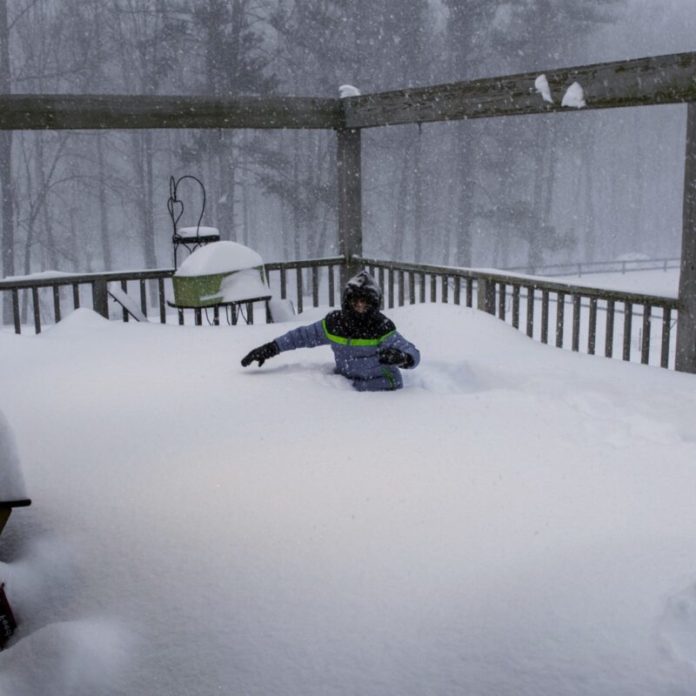Are you ready for winter? Ready or not, winter is taking aim at this country, and if you haven’t already, now is the time to get your winter preps done. Checklists are a great way to ensure you don’t miss anything.
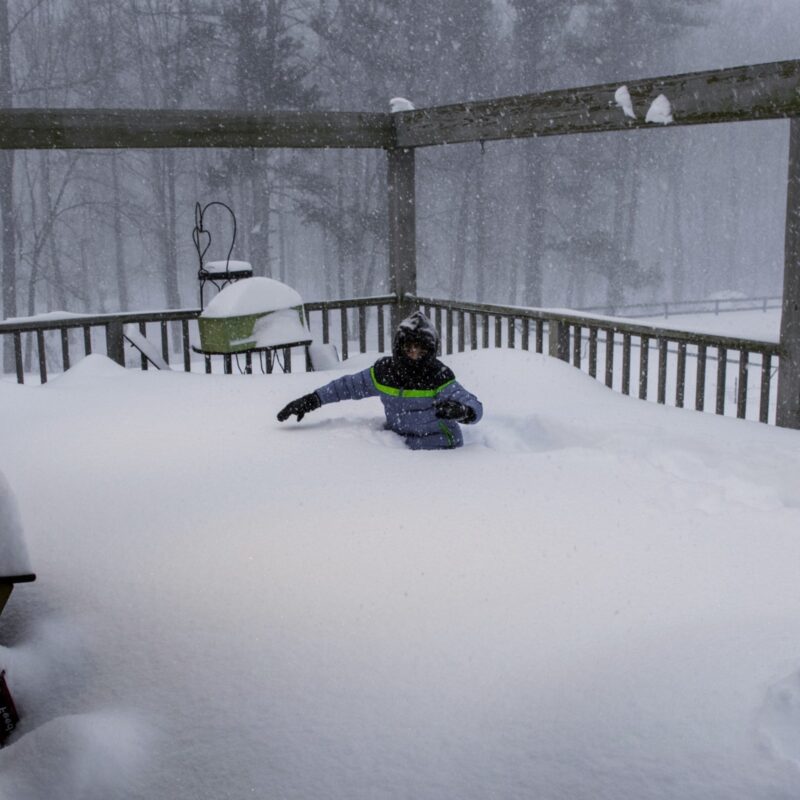
If you live in the North, you’re probably well ahead of the game. For us down here in the South, it’s about time to get going before another snow and ice storm hits, like last January. And, if you’re like me, you love to see a checklist with things you can go ahead and mark off right away, because you’ve already done it!
Home Winter Prep Checklist
Here are some of the ways you can prepare for cold temps, snowstorms, and lots of snow!
- Stock up on your alternative heating options — firewood, gas for generations, etc. Don’t forget about matches, lighters, fire starters, and all the other accessories needed to keep warm.
- Make sure you have plenty of water. You’ll need water for drinking, cooking, and personal hygiene, and for pets as well.
- Rotate your food storage if needed, and stock up on cold weather treats to have on hand. Hot chocolate, marshmallows for the kids, and plenty of beans and seasoning for chili are a great start.
- Get more batteries. You know you’ll use them.
- Check your gutters and downspouts. Clean them or have them cleaned.
- Make any repairs to your home that will ensure you stay warm and safe during any winter storm.
- Trim any tree limbs that could fall on the house if the weight of ice caused them to break.
- Winterize your pipes, appliances, windows, and doors. Check insulation and install storm doors if needed.
- Stock up on inexpensive games and toys for the kids to squash cabin fever. Or, put away some of the toys the kids already have and bring them back when the “I’m bored!” whines begin.
- Get a weather radio. Set it to notify you of any winter weather advisories, watches, or warnings.
- Understand the risks in your particular area. If you’re used to snow, ice or wind chills might be a bigger concern. If snow is uncommon, like in the South, where it tends to shut everything down, you’ll need to be ready to head to the store BEFORE the masses hit the streets.
- Sign up for weather alerts that are specific to your area. This is also great for spring and summer severe weather.
- Have a game plan for getting the kids home from school if it is canceled early. Also, go ahead and think about what you’ll do with the kids if school is called off for a day, and you still have to report to work.
- Print some checklists or spreadsheets to catalog your survival inventory. It’ll give you something to do when you can’t play checkers for the millionth time.
- Make notes of things that do and don’t work if you experience power outages or other quasi-end of the world situations.

Winter Vehicle Maintenance Procedures
The average person has no idea of what makes their vehicle operate, what maintenance items need inspection and up-keep, and when they are being ripped-off with unnecessary services designed solely for the profit of the repair shop. The truth is that maintenance is paramount.
- Make sure your car has plenty of anti-freeze, and that you’ve got more tucked away in your garage. Go ahead and check your other fluid levels as well.
- Check your windshield wiper blades. Replace them if they look worn or haven’t been doing a good job.
- Take a peek at your tires. Check the tread to make sure you’ve got adequate grip on the roads. Switch to snow tires if you live in an area where they are needed.
- Check your filters, spark plugs, and batteries. If you aren’t mechanically inclined, have an auto mechanic give your car a once-over.
- Make sure your all your lights are in good working order. Check the headlights, taillights, and blinkers.
Maintaining and prepping your vehicle for harsh and unforgiving winter weather is crucial to your success, and most especially if you are already in the middle of a crisis. Winter weather breakdowns are common, but it is still something that you can ill afford when lives are already on the line.
Make it a point to inspect and prepare your vehicle using the following checklist before the grip of winter fully tightens. Now as always, the time to get ready is before you need to!
Check Battery Health, and Consider an Upgrade
The batteries job is to start the engine and to also balance the entire electrical system. During its’ service life, the lead plates break down and become less efficient.
Have the battery and charging system tested with each oil change and replaced as soon as testing shows signs of fatigue. Modern testing equipment can show the percentage of remaining life in a battery.
Most readers already know that cold weather is hard on batteries, and many of us have come out of the office or to our driveways in the morning to discover that they have given up the ghost and no longer have the juice necessary to start our vehicles.
This is because low temperatures slow down the chemical reactions taking place in a battery; the very same reactions that make them function!
If they slow down enough, they will fail, and this is of course proportional to the health and charge status of the battery. A battery that is at the halfway point of its life or already lacking a good charge will suffer far worse and likely fail when the temperature plummets.

Accordingly, make sure you have your battery health inspected, not just the charge status, and consider upgrading to a newer battery and particularly one that is cold weather rated if you live in an area known for bitter, freezing weather.
Do Tires Need Rotating or Replacing?
Tires are another obviously critical component for safe travels in the winter time. You should always inspect your tires regularly, rotating them when necessary to prolong life through the evening of typical wear patterns.
You should also consider switching out your normal, everyday driver tires for specialty mud and snow or all weather tires that are better designed to maintain traction even when roads are slushy or covered with snow.
Tires of this type have deeper, wider grooves that will provide a channel for snow and water to enter, ideally allowing better contact between the surface of the tread and the road beneath. These tires really do make a difference, so consider it!

Inspect Belts, Hoses and Connections
Cold weather makes rubber and plastic brittle, and that means that critical belts, hoses and other connectors can seriously degrade or even fail entirely when the mercury starts falling. This is most often a show stopping event when you were out on the road, and you’ll be waiting on a tow should it occur.
But you can greatly reduce the chances that you’ll fall victim to this mishap by inspecting all of your belts, hoses and connectors that are made of rubber or plastic carefully for signs of degradation or impending failure. You might be able to squeeze out a little more service life and warmer weather, but cold weather will prove to be a severe test to any component so degraded.
You can change it now, and change it cheaply, or pay through the nose for a tow and emergency repair. The choice is yours!
Check Tire Pressure
Pay close attention to your tire pressure when the weather gets chilly. Lower temperatures means a reduction in air pressure even if your tires are leak free. Every 10°F that the temperature falls you’ll lose about one PSI in tire pressure.
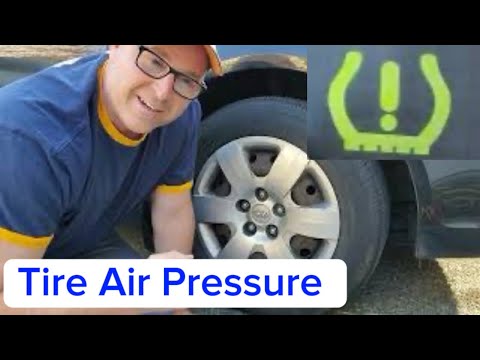
You’ll need to increase tire pressure accordingly to compensate if you want to stay safe on the road, but do keep in mind that your tire pressure will increase again as you travel and your tires start to heat up.
Don’t forget to reduce air pressure again as appropriate should you move into warmer climates or experience warmer temperatures any given day of the week.
Inspect Undercarriage for Corrosion
Winter weather impacting civilization means that roads will be salted pretty much everywhere you go, and this salt mixes with water and snow to form a corrosive slush that will readily build up on the undercarriage of your vehicle.
The most modern vehicles have coatings which help prevent serious degradation, any existing damage will be exacerbated by this corrosive salt.
For this reason, it is a great idea to go through the chore of inspecting the undercarriage of your vehicle for corrosion and having it attended to even if it is just a spot treatment before winter weather arrives and the salt trucks take to the roads in advance of it.
It doesn’t take too many winters of steady salt exposure for your undercarriage to start looking like a shipwreck at the bottom of the ocean!
Check Antifreeze Mixture
Lastly, but not least, take the time to verify that your vehicle has plenty of antifreeze mixture in the radiator and that the mixture is correct for the temperatures that you can expect to be operating in. an incorrect mixture might not be the end of the world, but a low antifreeze level could be disastrous.
If the mixture is wrong, either drain it and correct it yourself with fresh mix, don’t try to adjust the one that has been in there a while, or pay to have it professionally drained, flushed and replaced. This is not a big deal for most vehicles.
Winter Vehicle BOB Considerations
- Take a look in your BOB or GOOD bag/container. Is there anything you need to add to it?
- Add extra blankets to your car BOB, and throw an another blanket in your trunk or backseat.
- If you have warm-weather clothes in your bag, switch them out for warm clothes. Don’t forget extra pants, shirts, socks, and boots, in case what you have gets wet from snow or rain.
- Add extra socks to your car or bag. Extra as in, in addition to what you just put in there.
- Double and triple check to be sure you have enough warm clothes and blankets for your kids.
- Check the date and quality of the food and water in your car or BOB. Now’s a good time to rotate things out if you haven’t done it recently.
- Add some small toys or crayons and paper to make sure you can keep the kids occupied. Travel in winter weather can take longer than normal, even if it is safe to travel.
Your Winter Gear Checklist
Home
Food
You might not think it necessary to carry some emergency rations in your car as part of a well-rounded winter survival kit, but you might want to rethink that assumption.
Recent events have shown us that it is an easy thing to get stranded on a highway or the interstate as a result of intense winter weather, and if the thought of spending 24 hours in your vehicle sounds maddening, imagine how much worse it could be with a grumbling stomach.
Beyond this entirely common occurrence, consider that if you get well and truly stuck or crash in an out of the way place you might need to rely on those rations for energy if you are going to attempt self rescue.
Any food you keep in your car for the purpose must be completely shelf stable and not prone to bursting or otherwise becoming damaged should it be subjected to freezing temperatures.
Say what you want about military MREs, but they are perfect for this task as they are designed to withstand temperature extremes and remain completely edible with no preparation.
Water
If you need food, you’ll definitely need water, and this should come as no surprise to any prepper. However, this obviously will prove to be a challenge in winter weather since your water can freeze and burst whatever container is holding it.
To combat this endemic problem you have a couple of options. The first option is to load the water into your vehicle after you warm it up prior to traveling, placing it in the cabin where it will stay warmer longer.
The second option is to carry water in containers that you fill yourself, and leave enough space for the water to expand as it freezes so that it does not burst the containers. This necessitates thawing the water before you drink it.
Alternately, you might consider carrying a small metal camping mug or saucepan for collecting snow that you can melt.
First-Aid Kit
Much of the time when you find yourself in a life-threatening emergency it is in the immediate aftermath of an event that could cause you or someone else serious injury. This is a problem in and of itself, and further complicates your efforts to survive the bigger picture problem.
The solution is keeping a first aid kit on hand at all times in your vehicle and your home. This kit should be set up to deal with minor injuries like burns, cuts, various ailments and so forth as well as trauma that could be typical of a slip trip and fall or automobile accident. Tourniquets, splints, gauze, hemostatic agents and painkillers are a good idea.
Remember that this stuff won’t do you any good if you don’t know how to use it, so make sure you get trained and stay sharp!
Blankets
Good blankets are priceless when the temperature plummets, especially when you don’t have a sufficient source of heat, or your heat source is out of action entirely due to lack of fuel or other factors. Putting additional layers between you and the cold air is a prime factor in staying warm.
For emergency usage, you might consider heavy, sturdy wool blankets of the kind popularized by military service and outdoor explorers the world over, or invest in a space age emergency blanket.
Emergency blankets look for the entire world like an extra large piece of aluminum foil, but despite their seemingly delicate construction and feathery lightweight they work wonderfully to help keep the wearer warm by reflecting up to 90% of body heat.
You can make a good case for keeping both on hand at home and in your vehicle, but if space is at a premium consider the emergency blanket.
Cold-Weather Clothes
Cold weather means you need cold weather clothing. Obvious right? I hope so, but it bears repeating. Proper cold weather clothing outfits consist of multiple layers so that you may add layers to provide better insulation when you need them and remove layers to cool down so that you do not soak yourself with sweat.
Additionally, you’ll need appropriate socks, gloves and headgear to provide Total protection. This is something that is absolutely vital to have on hand whenever and wherever you might be deprived of climate control. No matter how warm your house is, it will get bitterly cold and very short order if you can no longer produce heat to warm it.
You should also keep at the minimum cold weather tops and bottoms along with headgear and gloves in your vehicle so that you’ll have a dedicated set if you become stranded.
Survival Candles
Multi-wick survival candles are an essential winter survival item. Aside from providing long lasting, reliable and simple light they can also meaningfully heat up a small space like a small bedroom, closet or the interior of a vehicle. You might use multiple, single wick candles for the same purpose but this will usually turn into a logistical challenge.
Survival candles are also designed to be extremely long and clean burning and have no fragrance whatsoever so they do not aggravate air quality and cramped quarters. The heavy duty metal containers and lids also provide a margin of safety and durability that is useful during an emergency.
Whatever kind of survival candles you choose, make sure you have a reliable way to light them in the form of matches or lighters.
Solar Charger
A solar charger wonderfully compliments your mobile devices by giving you true off-grid, portable electrical generation capability so long as you have unimpeded access to the open sky and the sun is up.
By orienting the solar cells directly towards the sun, UV radiation will be converted to electricity and either stored in an onboard power bank for distribution or directly piped into your device, be it smartphone, GPS or something else.
Harsh winter weather is notorious for knocking down our increasingly fragile power grid, so a capable solar charger makes a great addition to any winter weather survival kit. As always, you should test your kit ahead of time, particularly in cloudy or overcast weather, so you know what to expect out of it in less than ideal conditions.
Fire Extinguisher
A fire extinguisher is always a critical emergency tool to keep on hand every day of the year, but they are even more important during winter weather since house fires are disproportionately more likely to occur when people are running heaters, fireplaces and furnaces on high, to say nothing of an increase in cooking because no one wants to leave the house.
A fire extinguisher can save the day by smothering a small accidental Fire before it turns into a raging conflagration that will burn up your home and everything in it.
Make sure you have a properly serviced an adequately sized ABC rated fire extinguisher strategically placed in your home so it will be easy to access near the point where a fire is more likely to start, but not so close that it will be overtaken by the fire before you can get to it.
It is important that everyone in the home knows where the fire extinguisher is and how to operate it. In this regard, more, or bigger, is always better but ideally everyone that is of age should be able to handle it efficiently.
Vehicle
Maps, Atlas and Compass
It goes without saying, but your vehicle should always contain a reasonably up-to-date set of regional maps and a comprehensive road atlas along with a reliable compass.
I know that GPS systems today are ubiquitous and highly reliable whether they are built into the vehicle itself or married separately as your smartphone or some other device, but none of them will do any good if they are out of power or just don’t have any signal.
Especially considering How likely it is that you’ll need to detour to avoid the worst of winter weather or as a direct consequence of weather related accidents and traffic jams, having a reliable set of maps that you can reference could make the difference between getting to your destination and a timely fashion or becoming hopelessly lost trying to play it fast and loose.
Power Cell
Unless you are a prepping Luddite you probably rely on electronic devices for your everyday life and your survival preps as much as the next guy. There is much to commend these devices, but they are completely dependent upon electricity to function and once the power runs out the fun stops if you take my meaning.
You can help provide a hedge against loss of capability by keeping a fully charged power cell or spare battery on hand along with appropriate cables for your devices. The best of these can rapidly charge multiple devices at once several times and this could afford you life and sanity saving options during a long wait stranded in your vehicle.
As always, these devices might slowly lose their charge over time so make sure you keep an eye on them and keep them topped off before you need them.
Escape Tool
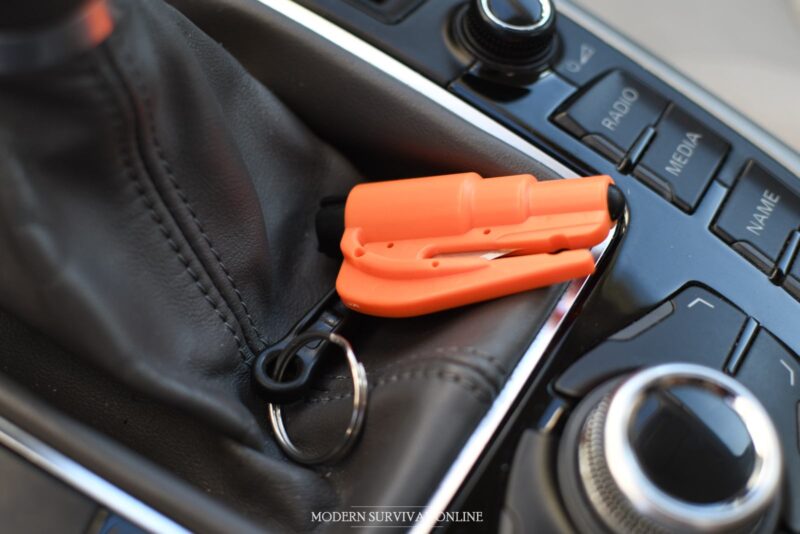
An escape tool is one that is purpose designed to help occupants of a motor vehicle get out of it as quickly as possible, even should the doors become jammed or blocked.
Typically consisting of an integrated, shielded seatbelt slashing blade and a spring loaded carbide tipped window breaking punch, keeping a pair of these within reach of the front seat passengers will help everyone get out in a hurry.
there are several other designs aside from the one described, everything from multipurpose mallets to small, credit card sized devices that clip conveniently onto a seatbelt harness. What matters is that you have one, know how it functions and make sure it is securely in place so that it is not fly around the cabin and get lost during a crash or collision.
Fire Extinguisher
The only winter survival item that is so good and important it is included on this list twice. All jokes aside though, you should have a fire extinguisher on board your vehicle at all times, and particularly during winter weather where loss of the vehicle could mean being without meaningful shelter should you become stranded while on the road.
A vehicular fire extinguisher must meet many of the same standards as the one you keep at home, namely it should be ABC rated, high quality, and properly maintained, but now you need to keep it in an equally durable mount that will keep it ready for instant use but also prevent it from becoming a deadly missile during a crash.
Flashlight, Lantern, Headlamp and Batteries
As mentioned before, winter weather often means crashes, mishaps and mayhem on the side of the road, and hear more than most other places you are likely to be facing darkness without an adequate amount of ambient light or other sources of light to help you take care of business. You’ll need to provide your own light, and that means you’ll need the right tools.
I like to carry an abundance of electric light sources on board my vehicle, especially during the winter. The more the merrier.
Lanterns can provide wide area lighting that also increases overall visibility, headlamps can help me get light where I need it when working on a vehicle or any other time I need my hands-free and flashlights once again are now as always a ubiquitous and useful choice.
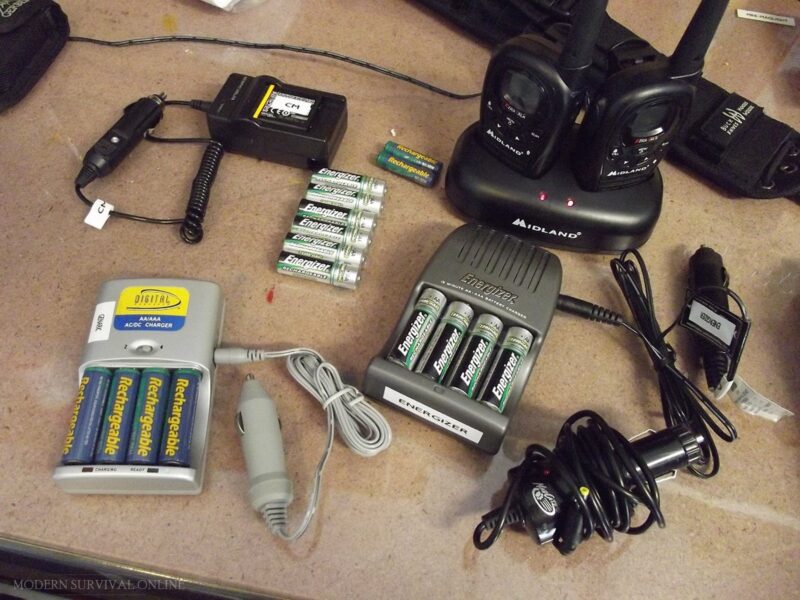
You also should carry at least one set of spare batteries for each of these devices. Specifically, try to choose lithium cells or another kind of battery that is less likely to lose performance or self-discharge quickly due to storage in a cold environment.
Jump Box
If you run afoul of a week or dead battery and don’t have any other drivers around to help you, you can give yourself a jump and get back on the road with a jump box.
Little more than an automotive battery with integrated, short jumper cables, a jump box is a convenient and reliable way to take care of one of the most common winter weather-related malfunctions under any circumstances. Easy to transport an easy to use, this is one of my favorite automotive preps.
One tip, though: make sure you choose a jump box that is adequate for pushing enough juice into the size of battery that your vehicle requires.
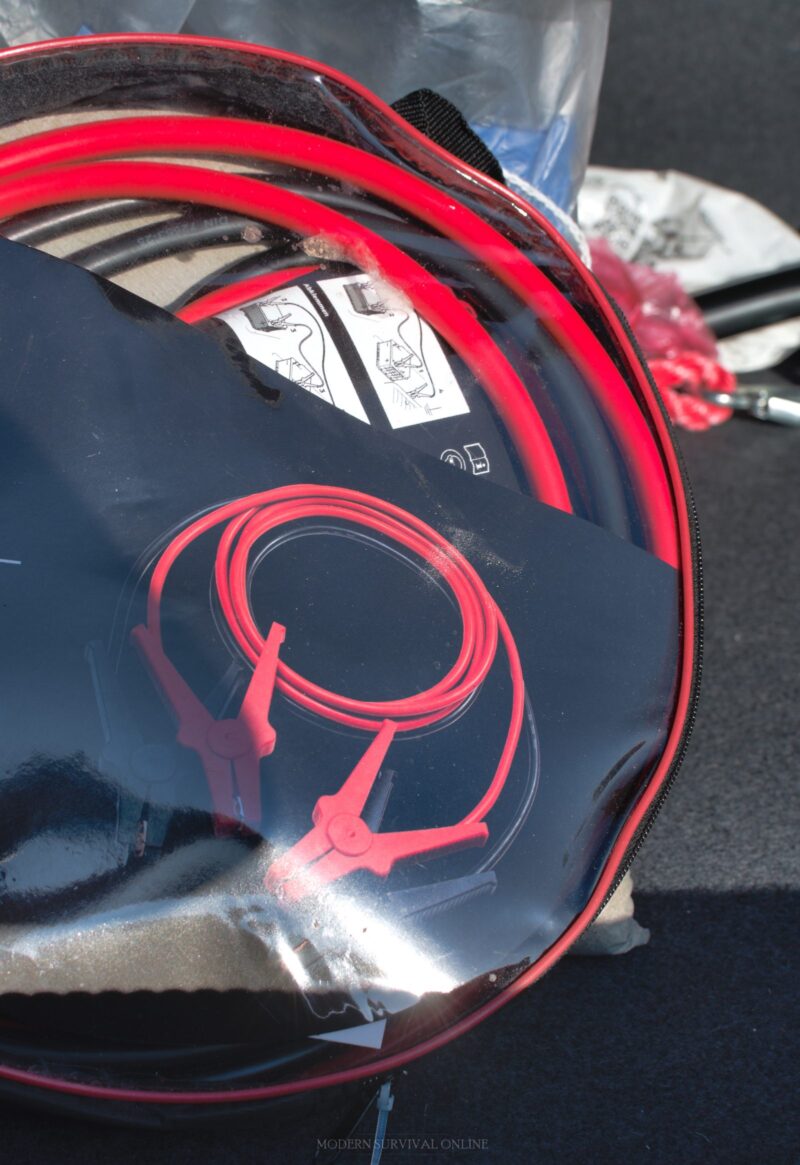
Jumper Cables
Jump boxes are great, but they rarely supply enough juice over time for multiple jump attempts. When the chips are down and you really need to get a battery going again, jumper cables are ideal, and can help recharge a battery that is on its last legs with the assistance of another vehicle.
Good jumper cables will be extra long to make positioning the assisting vehicle easier, extra thick to make sure they give enough power,, feature a heavy duty coating and solid copper contacts for maximum efficiency.
This is another item you should always have a board your vehicle, but most especially during the winter time!
Air Compressor
Sometimes a tire will lose air pressure or go catastrophically flat when you are a long way from a service station that can air it back up again. Once again, you can take care of the problem yourself if you have a portable air compressor as part of your vehicular winter prep complement.
Typically plugging into the accessory power outlet, these compact air compressors don’t deliver much force compared to larger, workshop size compressors but will reliably inflate the average passenger vehicle tire given a few minutes.
This item is doubly important if your vehicle does not carry a full size spare tire! Compact spare tires are only rated for low speeds and short distances, and can prove to be highly troublesome on road conditions typical of colder seasons.
Folding Shovel
A folding shovel, often known as an e tool, is the perfect item for digging your way out of a stuck situation should your vehicle slide off the road or become a snow bound in place by precipitation.
Compared to using an improvised device or even more, your hands, a folding shovel will make easy work of the job and help you get going quicker while using less energy. Even better, these handy tools fold down to the size of a large hardcover book and can be easily carried about any vehicle, even a motorcycle!
Tire Chains
Tire chains are a highly effective but often forgotten mobility upgrade for passenger automobiles. Although they can be quite fiddly to install, nothing works quite as well to provide grip on the slickest and iciest roads. In fact, they are so effective that some perennially cold places require these to be carried aboard all passenger cars by law!
You should have a set also, and know how to install them. Even if they are illegal or restricted in your area, dealing with the aftermath of that ticket is far better than being stranded somewhere because conditions got so hostile that vehicular travel was tantamount to suicide. When the chips are down, you want the grip that tire chains can give you.
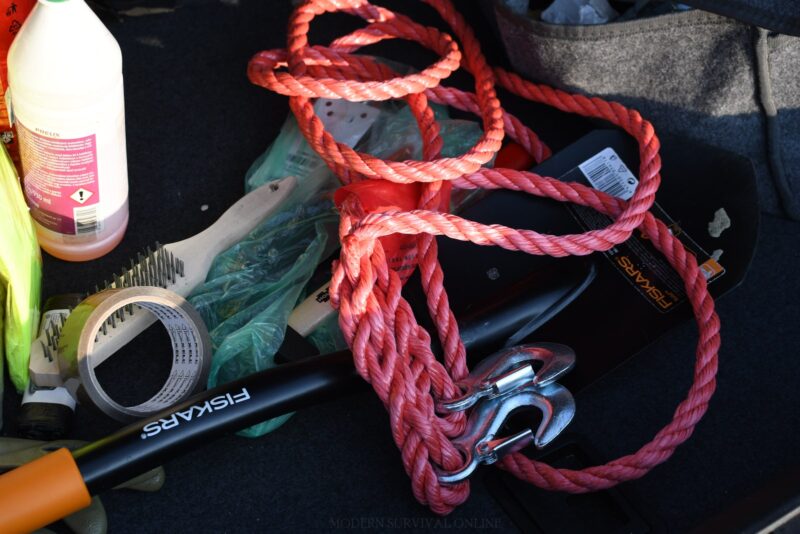
Tow Straps
Tow straps are lightweight, affordable and largely safe vehicular recovery devices that can allow an assistant vehicle to easily and safely pull another one out of a stuck spot. Compared to chains, there are stronger, lighter and safer to use.
If your vehicle has external hardpoints for towing, or a specially adapted bumper that will allow such, these are highly straightforward to use, but for other vehicles it might require a little bit of know-how and ingenuity. Make sure you learn how to use these before the time comes so you don’t botch it make things worse!
Bag of Sand or Kitty Litter
Vehicles typically get stuck or even totally immobilized in winter weather because they lose traction. In essence, snow and ice acts like a lubricant between the tire and the pavement or underlying ground.
One old-timer trick that works as well today as it did back then is the carrying of a bag of sand or kitty litter in your trunk when expecting wintery conditions.
By scattering a quantity ahead of all four tires, or behind them if trying to reverse, you can create a patch of high friction that can help get your vehicle moving again. Although it is quickly dispersed it might be enough to get you out of a jam. Plus, this is one winter weather prep that costs so little you really have no excuse for not having it!
Flares
Anytime you are forced to stop on the side of the road, be it delays, malfunction or an accident you’ll be engraved danger of being struck by following or oncoming traffic. Countless studies have shown that this occurs because other drivers either failed to see the stopped vehicle and pedestrians or did not see them in time to avoid them.
Accordingly, the single best thing you can do to increase safety in this all together two common occurrence is to brightly illuminate the area around your vehicle and leading up to it. The best and most noticeable tool for this job is the humble emergency road flare.
These flickering, bright pyrotechnic flares are more noticeable than literally anything else you can buy and are reliable enough to operate in all conditions, from blistering cold to driving rain. They even come with little stands so they don’t roll away. Get some, learn how to use them and keep them in your trunk, no exceptions!

A few PDF Checklists
Since it’s always more productive to work off a checklist, here are a few that are ready to print out and be put into action:
Ready For Winter?
What do you do to get ready for winter? What’s on this list that you hadn’t thought of or done? What can you add to this list to help someone else?

last update 01/30/2022


